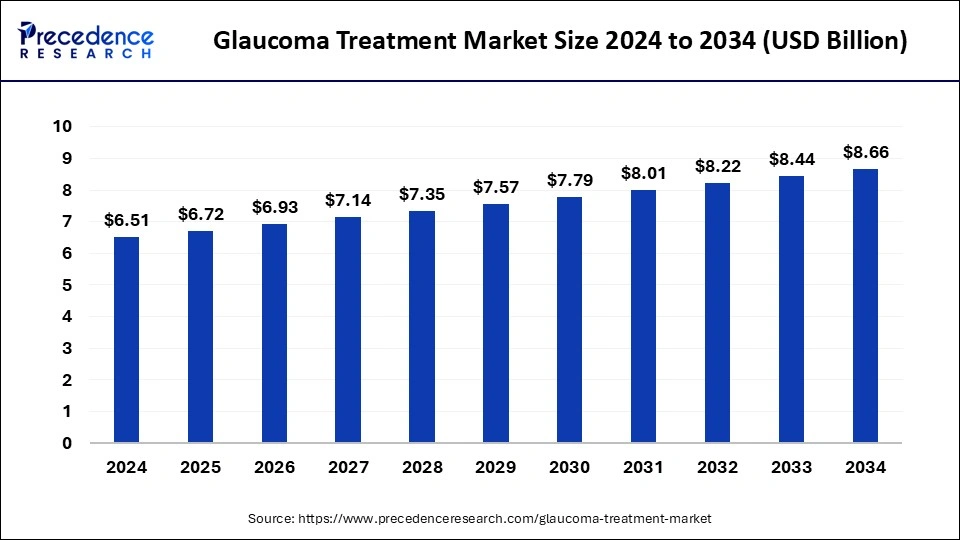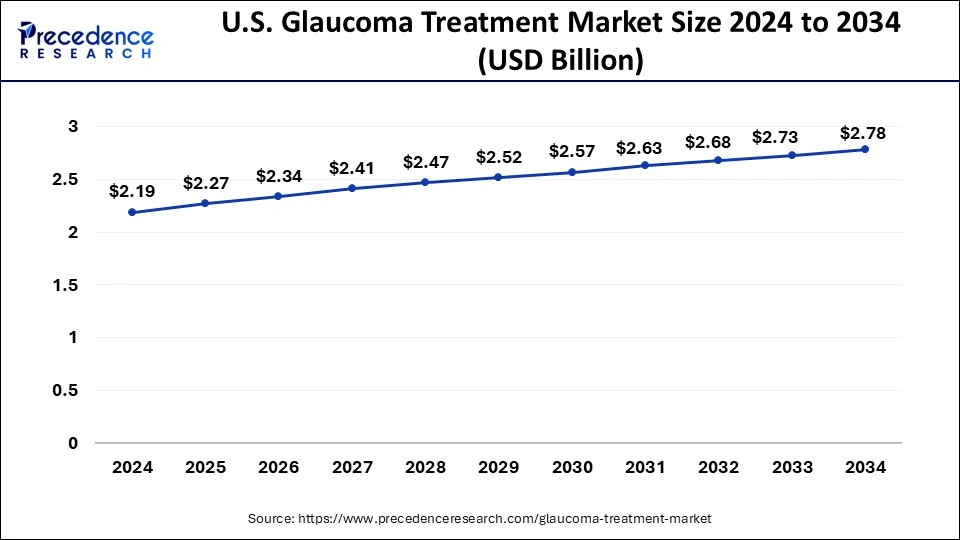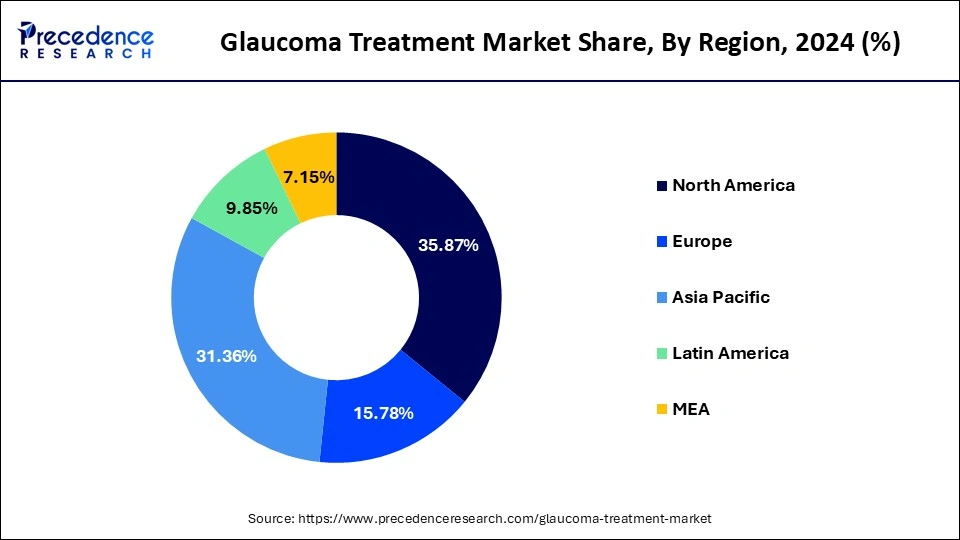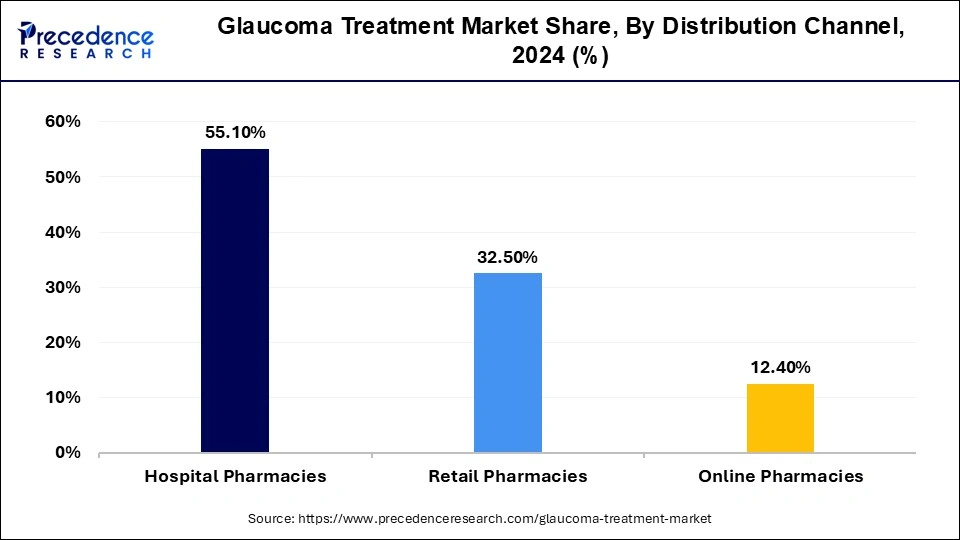October 2024
The global glaucoma treatment market size accounted for USD 6.72 billion in 2025 and is forecasted to hit around USD 8.66 billion by 2034, representing a CAGR of 2.86% from 2025 to 2034. The North America market size was estimated at USD 2.33 billion in 2024 and is expanding at a CAGR of 2.92% during the forecast period. The market sizing and forecasts are revenue-based (USD Million/Billion), with 2024 as the base year.
The global glaucoma treatment market size accounted for USD 6.51 billion in 2024 and is predicted to increase from USD 6.72 billion in 2025 to approximately USD 8.66 billion by 2034, expanding at a CAGR of 2.86%. The glaucoma treatment market is propelled by innovative solutions such as Nova Eye Medical's track Advance device, optimizing surgical outcomes with its illuminated fiber optic tip.

The U.S. glaucoma treatment market size was exhibited at USD 2.19 billion in 2024 and is projected to be worth around USD 2.78 billion by 2034, growing at a CAGR of 2.30% from 2025 to 2034.

North America led the global glaucoma treatment market with the highest market share in 2024. North America has historically dominated the market for glaucoma treatment due to several factors. Firstly, North America has a well-established healthcare infrastructure with advanced medical facilities and a high level of awareness about eye health among the population. This leads to early detection and diagnosis of glaucoma, resulting in a larger patient pool seeking treatment options.
Additionally, the region boasts a strong research and development sector, with pharmaceutical companies and academic institutions actively engaged in the development of novel therapies for glaucoma. The presence of key players in the pharmaceutical and medical device industries further contributes to the availability and accessibility of treatment options for patients in North America.

Asia-Pacific is expected to witness growth at a significant rate in the glaucoma treatment market during the forecast period of 2025-2034. The Asia Pacific region, particularly emerging economies within it, is witnessing rapid growth in the market for glaucoma treatment. Factors such as increasing healthcare expenditure, improving access to healthcare services, and a growing aging population contribute to the expansion of the glaucoma treatment market in this region. Furthermore, rising awareness about eye health and the adoption of advanced medical technologies are driving demand for innovative glaucoma therapies in countries like China, India, and Japan.
Glaucoma is a group of eye diseases that damage the optic nerve, often caused by high intraocular pressure (IOP). The main aim of treating glaucoma is to decrease IOP to slow down or stop the damage to the optic nerve and preserve vision. The type and severity of glaucoma determine the treatment approach, but it typically includes medication, laser therapy, and surgery.
Glaucoma medications are often the initial treatment for this eye condition, and they come in different forms, such as eye drops, oral medications, and injections. These medications work by either limiting the amount of fluid produced in the eye or increasing its drainage to lower intraocular pressure (IOP). Common classes of glaucoma medications include prostaglandin analogs, beta-blockers, alpha agonists, and carbonic anhydrase inhibitors.
Laser therapy can be used to treat glaucoma through procedures such as selective laser trabeculoplasty (SLT) and laser peripheral iridotomy (LPI). These treatments target specific areas of the eye's drainage system to improve the outflow of aqueous humor. Laser therapy is usually recommended when medications prove to be ineffective or not well-tolerated.
In advanced cases or when other treatments fail to control IOP, surgical interventions like trabeculectomy, minimally invasive glaucoma surgery (MIGS), or implantation of drainage devices may be recommended to create alternative drainage pathways and lower IOP, thereby preserving vision and preventing further optic nerve damage. Regular monitoring and follow-up care are essential to manage glaucoma effectively and prevent vision loss.
| Report Coverage | Details |
| Market Size in 2025 | USD 6.72 Billion |
| Market Size by 2034 | USD 8.66 Billion |
| Growth Rate from 2025 to 2034 | CAGR of 2.86% |
| Largest Market | North America |
| Base Year | 2024 |
| Forecast Period | 2025 to 2034 |
| Segments Covered | Disease Type, Drug Class, Distribution Channel, Formulation |
| Regions Covered | North America, Europe, Asia-Pacific, Latin America, and Middle East & Africa |
The aging population and rising prevalence of glaucoma
The aging population is a significant driver of the glaucoma treatment market. As individuals age, the risk of developing glaucoma increases, leading to a higher demand for glaucoma diagnosis and management.
With the global population aging rapidly, particularly in regions like North America, Europe, and Asia-Pacific, the prevalence of glaucoma is expected to rise. This demographic trend fuels the demand for innovative treatment options, including medications, surgical interventions, and minimally invasive procedures, to address the growing burden of glaucoma and prevent vision loss in older adults.
Technological advancements in glaucoma management
Technological advancements play a pivotal role in driving innovation and growth in the glaucoma treatment market. Novel diagnostic tools, such as optical coherence tomography (OCT) and visual field testing, enable early detection and monitoring of glaucoma progression, facilitating timely intervention and personalized treatment approaches. Additionally, advancements in surgical techniques, such as micro-invasive glaucoma surgery (MIGS) and minimally invasive procedures, offer safer and more effective alternatives to traditional surgeries, reducing patient discomfort and recovery time.
Moreover, developing sustained-release drug delivery systems and targeted therapies holds promise for improving treatment efficacy and patient adherence, driving market growth, and enhancing outcomes in glaucoma management.
High treatment costs and limited access to healthcare
One of the significant restraints in the glaucoma treatment market is the high cost associated with medications, laser therapy, and surgical interventions. Glaucoma requires lifelong management, which can impose a significant financial burden on patients, especially in regions with limited access to healthcare services or inadequate insurance coverage.
The high cost of treatment can deter patients from seeking timely intervention or adhering to prescribed therapies, leading to disease progression and vision loss. Additionally, disparities in access to specialized ophthalmic care, particularly in rural or underserved areas, further exacerbate challenges in managing glaucoma effectively.
Technological advancements driving innovation
The glaucoma treatment market is witnessing significant growth opportunities due to continuous technological advancements in diagnostic tools and therapeutic modalities. Innovations such as minimally invasive glaucoma surgery (MIGS) devices, sustained-release drug delivery systems, and advanced imaging techniques are revolutionizing glaucoma management.
These technologies offer improved efficacy, safety, and patient outcomes compared to traditional treatment options, driving adoption among ophthalmologists and patients alike. Moreover, the integration of artificial intelligence (AI) and machine learning algorithms into diagnostic devices holds promise for early detection and personalized treatment planning, further expanding the market’s potential.
Expanding geriatric population and rising disease burden
With the global population aging rapidly, the prevalence of glaucoma is expected to rise, presenting a significant growth opportunity for the glaucoma treatment market. The aging demographic is more susceptible to developing glaucoma, driving the demand for innovative therapies and management strategies to address the increasing disease burden.
Additionally, the growing awareness about the importance of regular eye examinations for early detection and management of glaucoma is driving patient engagement and demand for advanced treatment options. As healthcare systems strive to meet the needs of an aging population, investments in glaucoma research, development, and access to care are expected to fuel market growth in the coming years.
The open-angle glaucoma segment held the dominant share of the glaucoma treatment market in 2024 and is projected to sustain its dominance throughout the forecast period. Open-angle glaucoma, the most common form, is often treated with eye drops to reduce intraocular pressure (IOP), laser trabeculoplasty to improve drainage, or surgery to create a new drainage pathway. Medications like prostaglandin analogs, beta-blockers, or alpha agonists may also be prescribed to lower IOP.
The angle-closure glaucoma segment is expected to show the fastest growth in the glaucoma treatment market during the forecast period. Angle-closure glaucoma, on the other hand, requires more urgent intervention due to sudden increases in IOP. Treatment usually involves medications to lower IOP quickly, along with laser iridotomy or surgery to create a new drainage opening in the iris. This procedure aims to prevent further episodes of angle closure and preserve vision. Prompt diagnosis and treatment are crucial in angle-closure glaucoma to prevent permanent vision loss from acute attacks.
Global Glaucoma Treatment Market Revenue, By Disease Type, 2022-2024 (USD Million)
| Disease Type | 2022 | 2023 | 2024 |
| Open Angle Glaucoma | 4,953.9 | 5,127.1 | 5,302.5 |
| Angle Closure Glaucoma | 605.2 | 626.5 | 645.9 |
| Others | 527.9 | 544.0 | 559.6 |
The prostaglandin analogs segment dominated the glaucoma treatment market with the largest share in 2024. Prostaglandin analogs have seen a surge in popularity due to their efficacy in lowering intraocular pressure (IOP) with once-daily dosing, minimal systemic side effects, and high patient adherence rates. These medications work by increasing uveoscleral outflow, thereby reducing IOP and helping to preserve vision in patients with glaucoma.
The alpha agonists segment is expected to show the fastest growth in the glaucoma treatment market during the forecast period. Alpha agonists have also witnessed growth in usage as standalone agents or adjunctive therapy due to their ability to reduce aqueous humor production and enhance trabecular meshwork outflow. Additionally, alpha agonists are well-tolerated and have a low incidence of systemic side effects, making them attractive options for patients with glaucoma who may have comorbidities or are intolerant to other classes of medications.
Global Glaucoma Treatment Market Revenue, By Drug Class, 2022-2024 (USD Million)
| Drug Class | 2022 | 2023 | 2024 |
| Prostaglandin analogs |
2,035.4 | 2,113.5 | 2,189.2 |
| Beta-blockers |
663.0 | 687.0 | 710.9 |
| Alpha adrenergic Agonist |
1,078.0 | 1,110.3 | 1,140.7 |
| Carbonic Anhydrase Inhibitor |
1,390.8 | 1,441.3 | 1,491.5 |
| Others | 920.0 | 945.4 | 975.7 |
The hospital pharmacy segment dominated the glaucoma treatment market in 2024. Retail pharmacy growth can be attributed to its accessibility and convenience for patients seeking glaucoma medications and supplies. With an increasing awareness of the condition and the importance of consistent treatment, more individuals are turning to their local retail pharmacies for prescription refills and consultations with pharmacists.

The online pharmacy segment is expected to show the fastest growth in the glaucoma treatment market during the forecast period. The online pharmacy sector has also experienced rapid expansion, driven by the convenience of ordering medications from the comfort of one’s home. Online platforms offer a wide range of glaucoma medications, often at competitive prices, and provide an accessible option for those unable to visit brick-and-mortar establishments.
Global Glaucoma Treatment Market Revenue, By Distribution Channel, 2022-2024 (USD Million)
| Distribution Channel | 2022 | 2023 | 2024 |
| Hospital Pharmacies |
3,342.1 | 3,464.9 | 3,586.1 |
| Retail Pharmacies |
1,973.9 | 2,046.2 | 2,118.2 |
| Online Pharmacies |
771.1 | 786.5 | 803.8 |
By Disease Type
By Drug Class
By Distribution Channel
By Formulation
By Geography
For inquiries regarding discounts, bulk purchases, or customization requests, please contact us at sales@precedenceresearch.com
No cookie-cutter, only authentic analysis – take the 1st step to become a Precedence Research client
October 2024
September 2024
April 2025
January 2025